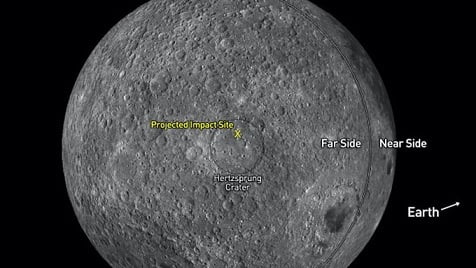Wandering Rocket Part Crashes Into Moon; All Hopes Now On NASA Orbiter or India’s Chandrayaan-2 To Photograph Spot

New Delhi: A rocket stage, believed to be part of China’s Long March 3C rocket that launched the Chang’e 5-T1 mission in 2014, has by now slammed into the moon’s surface as expected, creating a manmade crater that could be 65 ft to 100 ft wide, astronomers and agencies tracking the space junk said.
The rocket piece, hurtling at more than 5,500 mph or 2.5 km per second, slammed into a spot near the naturally formed Hertzsprung Crater on the far side of the moon.
There are no photographs yet of the crash or of the crater it created as the spot is out of view of ground-based telescopes. No orbiting spacecraft was also in position to photograph it.
In the coming weeks or months, however, NASA’s Lunar Reconnaissance Orbiter or India’s Chandrayaan-2 spacecraft, both of which are circling the moon, are likely to fly by the spot and send back pictures.
Rocket parts, orbiters and space probes have crashed into the moon before but those were intentional. Friday’s is the first unintentional collision of a manmade object into the lunar surface and highlights the problem of space junk in deep space.
Whose rocket?
Astronomers had been tracking the rocket part for years. It was first sighted from earth in March 2015 by a NASA-funded space survey in Arizona.
Six weeks later, Peter Birtwhistle (63), watching the skies for asteroids from his garden in Newbury, south of England, spotted it and passed on the images to US astronomer Bill Gray.
Gray believed the junk was the upper stage of a SpaceX Falcon 9 rocket that launched the Deep Space Climate Observatory (DSCOVR) satellite in February 2015. The junk was headed for the moon, he calculated.
Gray, working with other observatories, later said that the part did not come from a Falcon 9 rocket but belonged to China’s Long March 3C rocket. China has contested the claim.

Comments are closed.